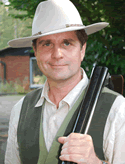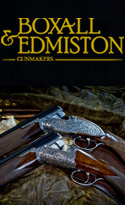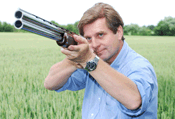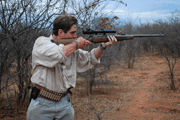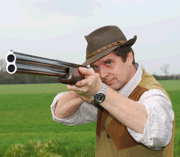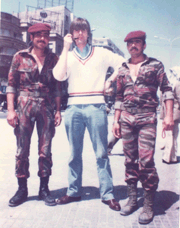An Unconventional Glossary of Shooting Terms - An Advanced Shooting Glossary
That old phrase Lock, Stock, and, Barrel is as good a place as any to start our ‘glossary’ of terms, because it refers to the most basic parts of a firearm.
The lock is the engine of any gun (double guns will have two). The parts of a lock mechanism usually include springs, sears, pins, and hammer. On pulling the trigger a sear is typically released and the compressed leaf (V) or helical (coil) spring energy powers a hammer/striker mechanism, driving a firing pin forward. This detonates the primer in the back of the cartridge.
The stock provides the gripping parts of the gun and something to attach the metal parts to. It may be made of wood, plastic, or other materials including fibreglass. The main parts of the stock are the butt (the rear, thicker, end from the action or receiver backwards), grip, comb(the top part of the butt upon which the face/head rests), and, forestock or forend. The stock’s gripping surfaces are often chequered or stippled to increase purchase (sometimes synthetic rubber panels are used for the same purpose).
The barrel is the tube-like piece of metal through which a projectileor projectiles are fired. The front of the barrel/barrels is called the muzzle/s. To the rear, there is usually a chamberinto which the cartridge is inserted. Barrels are smooth bored in shotguns, and, spirally grooved in rifles (hence rifling). Shotgun barrels often have a top rib as an aid to sighting. Rifles may be equipped with metallic or optical sights or both (as may shotguns on occasion when they are intended for use with projectiles such as ‘rifle slugs’ rather than conventional pellets).
Guns are made with many different action types. Shotguns may be single barrel or double break-action types with barrels configured side by side or over and under. The side by side was perfected in the last half of the 19th century by English and Scottish gunmakers, the over and under, in the first half of the 20th (by messrs. Boss, Woodward, and Browning). Although few know it, the muzzle-loading over and under actually pre-dates the side by side by at least 200 years, and, for Trivial Pursuitists, it might be added that the first British side by side appeared about 1750 (although breech loading side by sides did not achieve popularity in England until the 19th century).
Multi-barrel and combination weapons are occasionally seen (the German and Austrian Drillings and Vierlings are examples). Common break action types, however, are boxlock, boxlock-sideplated, and the true sidelock(Purdey-Beesley, Holland & Holland, and similar). In a true boxlock, most of the lock mechanism is contained in the box of the action itself. Striker and hammer are sometimes combined. Many boxlocks, however, have these components made separately. Guns with so called ‘disc-set strikers’ are an example of this (though not the only one). They have a striker assembly which may be removed with a two or three pronged key from the front of the action face or standing breech (which stands nearly perpendicular to the action table – the long part of the action bar).
In a sidelock, the locks are on lock-plates attached to either side of the main action body (they may also be quick-detachableby means of screws with finger levers positioned to the rear of the lock-plates). In side-plated guns, decorative plates are added to make a boxlock have the appearance of a sidelock. Sidelocks may be made with bar-actions, or, back-actions. In the former the main spring – a leaf type – points forwards and a cut is made in the action body to accommodate it. In back-action guns, common on best quality over and unders and, notably, double rifles, the spring is positioned behind the hammer and points rearwards and no cut is made in the main action body. It is therefore a stronger design – though it may be heavier. The Holland & Holland Dominion side by side shotgun, however, was famously made as a back action (as are some modern H&H shotguns still).
So called Round action guns may be encountered too (developed by Dickson, and, MacNaughton in Edinburgh, and, more recently, David McKay Brown in Glasgow). The term is sometimes applied to any modern shotgun with a rounded action body, but, used properly, it refers to a specific type of action different to the conventional box and sidelock. It makes use of a bow spring on a trigger plate. It may also be noted that many modern over and unders are mistakenly called boxlocks when in fact they are, in fact, trigger-plate guns (like the Scottish round actions). And, just to complicate the issue, some cheaper boxlock guns are also made with a trigger-plate as an economy measure. In all cases, the trigger plate guns dispense with the need for a separate bottom plate and carry their hammers on the trigger plate as well as the trigger mechanism.
Another common action type is the hammer gun, with external, visible, hammers. These are usually cocked manually, although self cocking hammer guns are occasionally made as exhibition pieces or expensive novelties. Hammer guns of older type may have a half cock as seen on muzzle-loaders – hence ‘going off at half cock’ – or, may be made under the later Stanton patent which dispenses with the half cock position and keeps the uncocked hammer safely off the striker (the older type of hammer action was the cause of many accidents when sportsmen fell or the gun was dropped). These later type hammer guns are known are said to have rebounding locks. There are many other unusual actions types such as the Darne sliding-breech.
Most modern break-action guns have a top-leverfor opening (developed by Webley many years ago). Old guns, may have a side-lever, or underlever. There are many other systems and it goes beyond the scope of this article to consider all of them. Shotguns may be made with or without ejectors, moreover. In side by sides, the most common ejector system, working on the over-centre principle, is that called ‘Southgate’ which is simple and reliable and now used by most makers. There is more variation in modern over and under ejector mechanisms, some have sprung extractors which are tripped (as in Berettas), some have hammer ejector mechanisms in the forend (Miroku and many Brownings).
Shotguns may have double or single triggers. The latter may be selective and usually operate on an inertia(recoil activated by a bob-weight)or mechanicalsystem (the former now more popular). Many single triggers incorporate a third, imperceptible, pull to prevent ‘doubling.’ The single trigger is an ancient invention, but became popular in the 19th century when live pigeon shooting – the direct ancestor of clay pigeon shooting – was a popular sport and any small advantage was being sought by competitors because large sums of money were at stake.
Another refinement of shotguns is a self-opening, or, assisted-opening mechanism. The Purdey sidelock, designed by Frederick Beesley circa 1880, brilliantly, uses one leg of its V type mainspring to power the tumbler and the other to power the self-opening feature. Holland & Holland guns have assisted opening by means of a coil spring and plunger assembly positioned under the barrel (the tube which contains this is hidden by the forend, it is not present in all their guns but is a normal feature in later production Royals).
Shotguns may have an automatic or non-automatic safety (the former usually seen on game guns). On double gun they are usually activated by a sliding thumb-piece on the top-strap. On repeating guns bar-type safeties are often seen on or near the trigger guard. It should never be forgotten that safety mechanisms may be no more than a trigger-block. Sometimes, they may include one or more intercepting sears to prevent cocked locks being activated when accidentally jarred (so called ‘safety’ catches are no guarantee of safety, however – NEVER POINT A GUN ON SOMETHING YOU DO NOT WANT TO SHOOT).
Repeatingshotguns are also popular (also called repeaters). There are, primarily, of two types: pump-action and semi-automatics (although revolving chamber guns are occasionally seen). Semi-automatics guns, often called simply ‘semis’ operate by three systems usually – gas (the most common – inspired by the assault rifles of WWII), recoil (once dominant and seen in the original Browning A5, Breda and Browning Automatic), and inertia (Benelli and the old Sjogren).
Rifles may be bolt-action, straight-pull, lever-action(like the famous Volcanic and Winchester guns), pump-action, revolving chamber, break-action as with shotguns, falling-block, and semi-automatic amongst others. The Mauser 98 style action, developed by the Mauser brothers in the 19th century developing the door-bolt action principle of Von Dreyse, is still the most common type and has inspired many other designs. The Mauser action is a so called controlled-feed action where the bolt picks up a cartridge and controls it into the chamber, rather than merely pushing it in as with push-feed guns like the Tikka and Remington 700.
The Mauser and Remington 700 have twin-lugs at the front of the bolt-headfor locking (and a rear safety lug as well). Some rifles, including recent Sakos, may have 3 (or more) lugs at the front of the bolt head. The Mauser 98, pre-64 Winchester, and similar Mauser 98 inspired designs are also notable for having a massive claw extractor. Their functional reliability under adverse conditions is often attributed to this feature. It is often demanded on bolt action rifles intended for dangerous game.
The cartridge has a number of components. In shotguns – there will be a case, a wad, powder, shot (usually about 300 small pellets) and a primer to the rear. The wad may be plastic (often with a petalled cup), fibre, or, felt. It acts as the piston-like driver when the powder is ignited by the primer. The primer is located centrally in the rim of the cartridge. Inside the primer, there is a tiny anvil, the primer itself is usually located, moreover, in metal cup in base of the cartridge (shotguns). The powder, also called propellant, may take the form of flakes, grains, rods, or little balls, and is usually of two types: single-base or double-base.
Rifle cartridges usually include case, primer, propellant and a bullet/projectile. The latter may be of expanding or non-expanding type. Typically, they are lead cored (though bullets have been made from other materials including steel, solid copper, various alloys, and metal powders bonded with plastics). Most bullets will have a thin copper ‘jacket’ over the lead core, though non-lead bullets such as those made by the US firm Barnes are becoming increasingly popular. There is considerable discussion of so called ‘non-toxic’ ammunition at present – though evidence of harmful effects of lead as far as bullets and shotgun pellets are concerned is not entirely convincing.
The stock of the gun is the wood work as noted. And, as discussed, the thicker part to rear, may properly be called the butt (though sometimes, rather confusingly, it is just called the stock as well). The butt may or may not have a defined cheek-piece. Many shotguns do not have an extra cheek piece. They are frequently seen on rifles, however. Nevertheless, a Monte-Carlo comb is common on trap guns (those used for clay shooting at trap birds where targets are all going away within a defined forward arc). The Monte-Carlo comb has a raised section, usually parallel to the rib axis, with a step at the rear of the gun. Monte-Carlo stocks are usually higher than conventional ones, but this is not an absolute rule. Kidney, Roll-Over, Tyrolean, and Asymmetric combs are also encountered, all but the first, are normally reserved to rifles.
The part of the stock that you hold with the rear hand is the grip or hand, and may take various forms as well. On shotguns, there may be a straight-hand grip, a semi-pistol, Prince of Wales, or fullpistol. Some grips have a so-called palm-swell on one or both sides as an aid to gripping. Though, if poorly designed, they may impede the way you hold the gun. On rifles (and, very occasionally, shotguns) you may also encounter the thumb-hole stock, which, literally, has a hole for the thumb and a near vertical grip shape. Some military weapons have a vertical pistol grip that is separate from the main stock and looks much like a semi-automatic handgun grip.
The radius of the grip is an important issue on sporting guns (and should match the user’s hand). More commonly considered dimensions include the length or length of pull of the stock, its dropor bend – the extent to which the top of the comb deviates down from the rib axis (shotguns), bore axis (rifles), and cast – the deviation of the butt from the central axis to right or left (cast is frequently seen in shotguns and some better quality rifles).
The stock will usually be made of walnut in shotguns, although composite stocks are increasingly popular on repeaters. Rifle stocks may be made of natural wood (usually walnut or birch), laminated wood, or various composites. ‘Glass’ or epoxy bedding of barrel and action into the stock on rifles is common. Some modern rifle stocks may offer an alloy chassis onto which the barrel and action are attached. As with glass bedding, this offers increased stability (and has been widely adopted by the military for sniper rifles).
The front of the stock on shotgun is usually called the forend – common types include the schnableor snabelwhich has a lip to the front (the word itself means bill, as in duck’s bill). The splinter forend is popular on side by sides. The wide Beaver-Tail is seen on both side by side and over and under shotguns. There is vast variation of shape and proportion. The front of the rifle stock is usually called the forestock.
Barrels on shotguns may be made by various systems including, most commonly, monobloc, where two tubes are inserted into a monobloc (a system developed by Beretta circa 1900 – though invented previously). Chopper or demi-lump barrels, the former seen on side by sides, the latter on over and unders, have the barrel and lump forged in a single piece (called chopper because the forging looks like an axe). This means there are only two main components rather than three. Double gun barrels may also be made with dovetaillumps and through-lumps. Shotguns are sometimes repaired by sleevingwhere the barrels are cut off forward of the chamber and re-tubed liked a monobloc gun.
Beneath the barrels of double guns one will usually find two (Purdey system) lumps which locate in a slot in the action table and are locked by a bolt or boltscoming forward from the breech face. On over and under guns there may be a slot bite for this bolt to engage in beneath the bottom chamber, or there may be square or round female bites to either side of the chambers (Boss, Perazzi, Beretta). In break action guns there will be a hinge or cross pin upon which the barrels pivot. In over and unders bifurcated lumps are often encountered which are machined into the sides of the barrels (they do not project underneath). These are combined with split/stud pins for hinging (the advantage of this system is that it reduces action profile).
Rifle barrels may be made of stainlessor carbon alloy steel. They have spiral grooving internally, called rifling, to impart spin to a single bullet. The high part of the rifling is called the lands, the troughs, are called the grooves. Rifle barrels have different twist rates (such as 1 in 12 – 1 turn in 12”). Barrels may be made by cutting, by the button rifling process, or by hammer forging (also common in shotgun barrel mass manufacture). Rifle barrels must be made with great precision. As with shotguns, there are subtle differences in bore diameter regardless of nominal calibre/bore. The chamber is also a critical area, and, the lead from the chamber to main bore is another important issue (it will dictate the distance from the bullet to the beginning of the rifling). Headspace on rifles (and shotguns) is another important consideration. If it is too great recoil will be increased.
Shotgun barrels have a funnel-like constriction forward of the chamber called the forcing cone. These may vary in length from ¼” to several inches. Some shotguns have no cone at all (so called chamberless guns). The bore size of a nominal twelve bore (called such because 12 lead balls of the bore size weigh 1 pound) may, in fact, vary considerably, both because of deliberate or accidental manufacturing difference and because of wear and repair. The extent of this variation is regulated to some degree by proof(the testing of the gun by an especially powerful charge which is usually carried out in the UK and Europe by regulated bodies affiliated to the International Proof Commission CIP – no similar system is in place in the United States or Japan).
At the end of a shotguns barrels – an area called the muzzles – one will usually encounter a degree of constriction called choke. The length of this constriction varies as does its form from manufacturer to manufacturer. Usually, there is a choke cone leading to the constriction. The choked area itself is typically a parallel section, but cheaper guns may be swaged at the muzzles to create the choke. They have a simple conic form (this is also seen in the popular Teague chokes which dispense with the parallel section too). Choke works like the nozzle of a garden hose to concentrate the pattern of shot. Interchangeable chokes – also called multi-chokes – are common today on over and under and repeating guns and offer the convenience of easy changes of constriction to suit different types of shooting. Variable choke devices are also available for repeaters, but are not as popular as they once were.
Shotguns barrels are usually equipped with both side (joining) ribs and a sighting rib with a single front sight (also called a bead). Some guns have a mid-bead as well. On side by sides, the concave or ‘game’ rib is the most popular type, although flat ‘pigeon’ ribs may also be encountered, as well sunken ribs. On over and unders the dominant rib type is the ventilated rib which may be made flat or raised. Ribs may be tapered too. Expensive bolt-action rifles may have a quarter-rib forward of the receiver which is used as a base for the rear sight and for decorative embellishment (it is usually added on, but, on old rifles of quality, such as the Rigby, may be integral).
Finally, we might briefly consider air guns, which may be made in various forms and calibres (commonly .177 and .22 with .20 and .25 being encountered occasionally). In the UK an air gun may be possessed without a certificate if it is less than 6ft. lbs (pistols), and 12 ft. lbs. (rifles). You must be 18 or over to buy one. Some airguns are powered by springs acting on pistons, commonly called ‘springers.’ Such guns may cock by ‘breaking’ the barrel or by means of a long sidelever or underlever. The gas-ram, is an evolution of the piston-spring concept, where the spring is replaced with a self-contained gas/piston unit like a gas operated shock absorber in a car’s suspension. ‘Recoil-less,’ or, more precisely, semi-recoiless air-rifles have been made with twin opposing pistons and using a sledge mechanism where the barrel and other parts move rearwards on firing.
Truly recoiless pneumatic air-guns are very popular today. These may be pumped up with an attached lever, or, more commonly, have an internal reservoir charged using an external pump or compressed air cylinder – so called pre-charged pneumatics. Air guns may also be powered by small disposable CO2 cylinders in 12 gram size these may be called ‘powerlets’ (a trade name of the Crossman company - this size is commonly used in pistols). Rifles, and, notably, repeating guns, may make use of an 88 gram version called sometimes ‘Air Source’ (another Crossman trade name). Air-soft guns fire lightweight plastic 6mm plastic BB balls at lower power. These may be powered by a variety of green gases (such as Freon), or, a spring piston, or, a battery powered electric piston mechanism.


